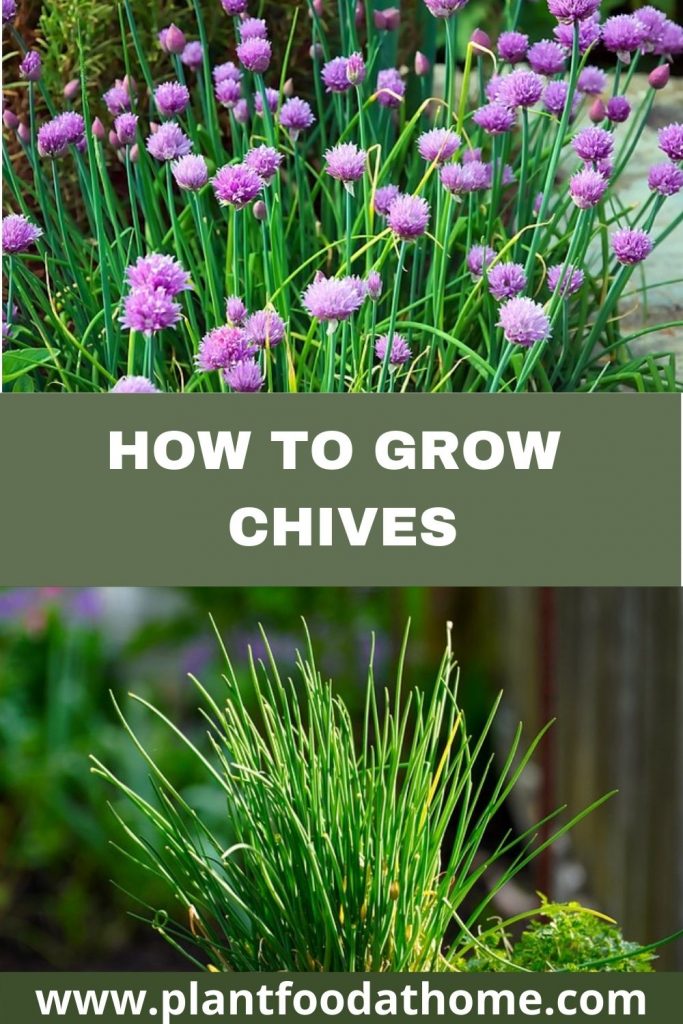Chives are well-known for being one of the easiest herbs to grow thanks to their hardy, low-maintenance nature. A tasty addition to many dishes, these perennials belong to the onion family and are entirely edible from bulb to flower, making them an excellent, versatile choice for your garden, greenhouse, or even your kitchen windowsill. Whether you’re a green thumb or a gardening newbie, here is everything you need to know on how to grow chives in your herb garden.
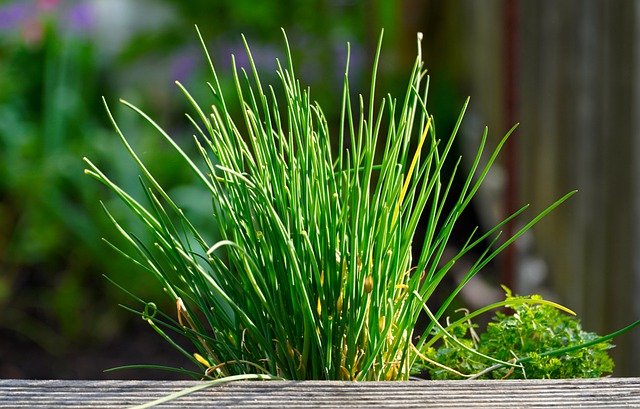
Table of Contents
Varieties of Chives
There are two main types of chives to note:
- Common chives (Allium schoenoprasum): small, scallion-like bulbs producing slender, tubular, grass-like leaves with pink-purple flowers and a mild onion flavor.
- Garlic (or Chinese) chives (Allium tuberosum): less common with flatter, more angular leaves, white flowers, and a more pronounced garlic flavor. They also take a little extra time to grow.
Best Growing Conditions for Chives
One of the biggest benefits of growing chives in your herb garden is their tolerance and minimal maintenance. They grow well in most conditions, whether you prefer to grow chives in pots or the ground, or live in a warm or cold climate. And once you discover how easy chives are to grow and how fantastic it is to have fresh herbs from your garden, you’ll be hooked on growing your own herbs!
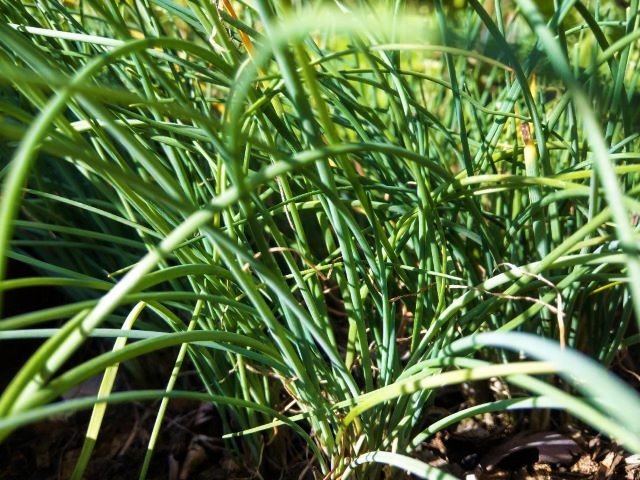
Climate
Chives grow best in temperatures 60-85°F (15-30°C). If you reside somewhere with a cold winter climate, your chives will go dormant during the cold months until the temperatures warm up in springtime.
For those of you with warm temperatures year-round, your chives might be evergreen and enjoyable the entire year.
Soil
Fertile soil with good drainage is ideal for growing chives. The addition of compost and well-rotted manure will help soil fertility and promote good drainage. Though chives are very tolerant and will do just fine in a range of soil types.
A pH range of 6-7 is ideal if you like to test your soil, you can use a soil monitor here, or you are looking for the ultimate potting soil to purchase for growing chives in pots.
Sun
For chives to thrive, plant them where they will receive full-sun of 6-8 hours a day or partial-shade, particularly in very warm climates. Happily, though, chives are very tolerant and will grow almost anywhere.
For indoor chives, give them a spot that will expose them to at least four to six hours of sunshine.
Water
Keep chives well-watered to ensure the soil is moist (but not waterlogged) during the initial growing season. Young chives require more attention than older plants, so you may need to water them 2-3 times a week, depending on your climate. Once established, chives can tolerate a bit of dry soil, but still need some extra irrigation during dry spells.
Fertilizer
You can aid growth with an organic herb plant food fertilizer such as this one but try not to overfeed your plants. Excessive fertilization may affect the health and flavor of your chives!
If your soil isn’t nutrient-rich, working in a nitrogen-heavy fertilizer can improve growth. Nitrogen can be organically added to your soil with coffee grounds, composted manure, or by planting nitrogen-fixing plants such as peas or beans prior to planting chives.
Mulching around chives with organic mulch will help retain soil moisture and protect the plants. Additionally, organic mulches breakdown over time and help feed the soil which will keep your plants happy and healthy.
Chive Plant Spacing
Chives are a clumping plant that will spread to around 12 inches (30cm) in ideal conditions. They will also grow to 8-12 inches (20-30cm) in height. So when planting them out in the garden, initially space them around 4 inches (10cm) apart.
If chives become crowded as they mature, later on, you can divide them up and give them more space of up to12 inches (30cm) apart. This will give the chives more room to grow. More on dividing chives a little further on.
How to Start Chives From Seed
To get a head start on the growing season, chive seeds can be started indoors, 4-6 weeks before the last expected frost, usually in late winter or early spring. Seeds can be sown in trays or pots to transplant in spring or early summer.
Chive seeds can also be planted directly into the garden when all chance of frost has passed and the soil temperature is 65-70°F (18-21°C). You can check the soil temperature with a soil thermometer.
- Sow a few seeds together around 2 inches (5cm) apart. Plant seeds 1/4 inch deep (6mm) lightly covering with soil.
- Keep the soil moist so that it doesn’t dry out. Germination can take 14 to 35 days, so patience is needed here.
- Once indoor seeds have germinated, the chive seedlings will need a sunny window or a grow light to keep them growing.
- Seedlings can be transplanted into your herb garden or a larger container when they are around 2 inches (5cm) tall and the weather has warmed up.
Chive seedlings grown indoors should be ‘hardened-off’ to avoid transplant shock before transplanting them outdoors. This is the process of gradually exposing plants grown indoors to sunlight and outdoor conditions. You can read more in our article Hardening Off Seedlings (& Avoiding Transplant Shock).
Dividing Established Chive Plants
Dividing established chive plants is easy and will provide new plants from existing plants. It is generally done when plants are 2-4 years old and it helps to give the chive plant more room to grow.
- To divide the chives plant, gently lift the entire plant from the ground by digging at least a few inches deep around and under the plant to prevent any damage to the roots.
- Then using garden shearers or secateurs, cut the chives plant in half or even quarters.
- Next, simply transplant your new chive plants into another part of the garden or into pots.
- Water the divided chives plants well until they are established.
How to Grow Chives in Pots
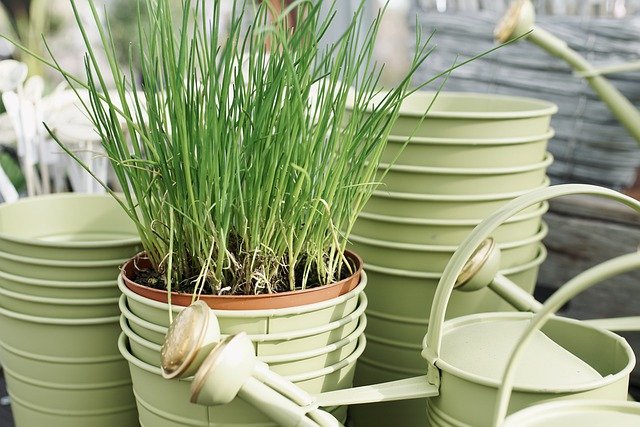
Growing chives in pots is easy and convenient. Pots can be grown on balconies or even kitchen windows. And actually, I prefer to grow chives in pots so I don’t mistake them a weed in my garden! But a quick tip here to distinguish chives from grass is that chives grow hollow blades and they’ll have a garlic-like smell.
- Choose a pot or container at least 6 inches (15cm) deep. Remember, chives can eventually spread to around 12 inches so it’s a good idea to give them some room to grow. Chives in pots require good drainage, so ensure your pots have drainage holes in the base.
- Fill the pot with a light, high-quality organic potting mix.
- Plant either chive seeds, seedlings or your plant divisions around 4 inches (10cm) apart.
- Water in well and keep lightly moist.
- Mulch with an organic mulch to help retain soil moisture.
- Place the pot in a sunny position to receive 6-8 hours of sunlight a day.
Common Pests and Diseases
Luckily, chives are not too bothered by pests. Young plants should be protected from slugs and snails. And occasionally, you could get onion thrips, but they tend to stay away from regularly watered plants. When the shoots are new, especially if located in a greenhouse, they can be prone to greenfly. To get rid of them, simply pluck and squash them.
If chives are crowded and in high humidity, they can develop fungal diseases such as leek rust. Avoid crowding the plants and cut any severely affected leaves to prevent spread.
How Long Does it Take To Grow Chives?
From planting chives seeds until harvest, it takes about three months to grow chives.
After sowing chives seeds, you will see seedlings begin to germinate 14-35 days later. And you can start harvesting chives when they are 6 inches (15cm) high.
How to Harvest Chives
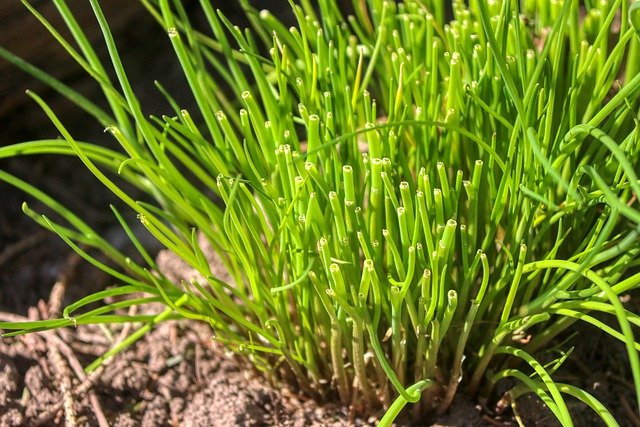
One of the best features of chives is their high yield. The more you take, the more they give; cutting the leaves will encourage them to produce more.
Once the chive plants are around six inches (15cm) tall, you can start harvesting them as needed. Established chive plants will provide a continuous harvest between early spring and fall.
Harvesting is as simple as snipping them close to the base roughly 1-2 inches (2.5-5 cm) above the soil so the leaves will regrow. Harvest chives starting with the outer leaves, using a pair of scissors or garden shears, removing up to 1/3 of the plant at a time. Give the plant time to regrow before harvesting again, from a different part of the plant.
In cooler climates, it’s best to stop harvesting chives three weeks prior to the first expected frost in the fall or winter. Once chives die back, clear any dead foliage away to make room for the new growth in the spring.
Chives flowers can be removed to prolong the production of the plant. And they are entirely edible! Young chives flowers are delicious in salads, or you could use them purely as a garnish or decoration for soup. If you allow them to fully develop, the flowers will scatter the seeds across your garden and cause a chives takeover, although you can easily dig up the invading plants and move them.
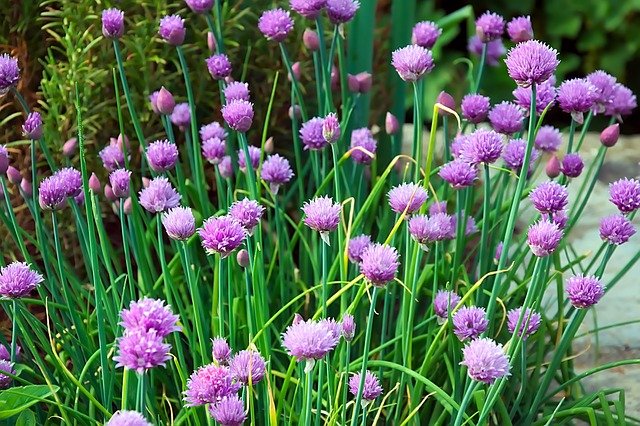
How to Store Chives
Chives will lose some of their flavor upon cooking or drying, so try to take advantage of them while newly harvested and uncooked for optimal taste. Although best used fresh, you can store them:
- In a sealed plastic bag in the refrigerator for up to seven days.
- In the freezer by finely slicing them, putting them into an ice-cube tray, and adding a little water before popping them in your freezer. You can preserve frozen chives for up to one year.
- In an airtight container after drying them in a warm spot, out of the sun with good air circulation.
Conclusion
Chives are the perfect herb to get your garden started thanks to their versatility, hardiness, and low-maintenance qualities. Whether you’re just starting out or an old hand at the gardening game, these plants will help build your confidence because they’re just so easy to grow. Once established, just sit back, and enjoy watching your chives flourish!
Recommended Products:
- Heirloom Herb Seeds
- Organic Herb Fertilizer
- pH, Soil and Water Gauge
- Organic Seed Raising Soil
- Soil Thermometer
- Organic Potting Soil
- Seedling Heat Mat
- Grow Lights
Further reading:
- Dying Chives? 6 Common Causes with Solutions
- How To Grow Cilantro: Tips For Growing Cilantro
- Drought Hardy Herbs To Plant At Home
- How To Grow Mint: Complete Guide To Growing Mint At Home
- How To Grow An Abundance Of Dill For Your Edible Garden
- Growing African Blue Basil: Plant Profile and Propagating
- What’s Eating My Mint? (Holes in Mint Leaves)
- Why Are My Leeks So Thin? (And how to fix them!)
